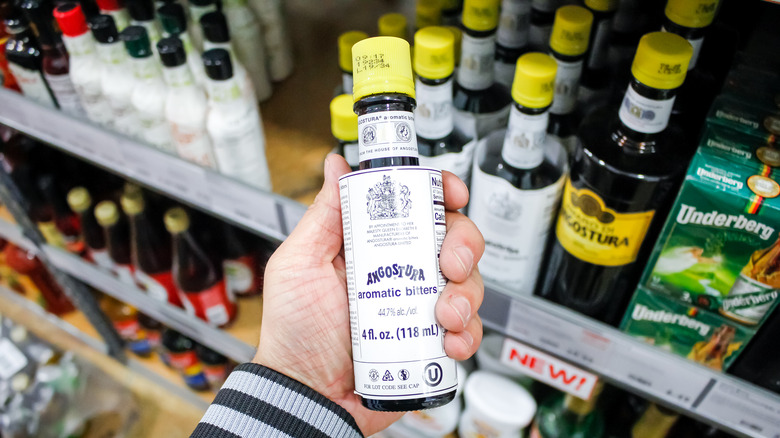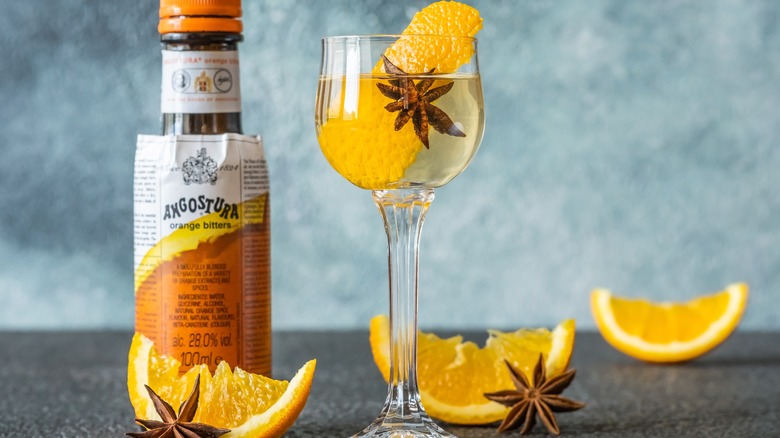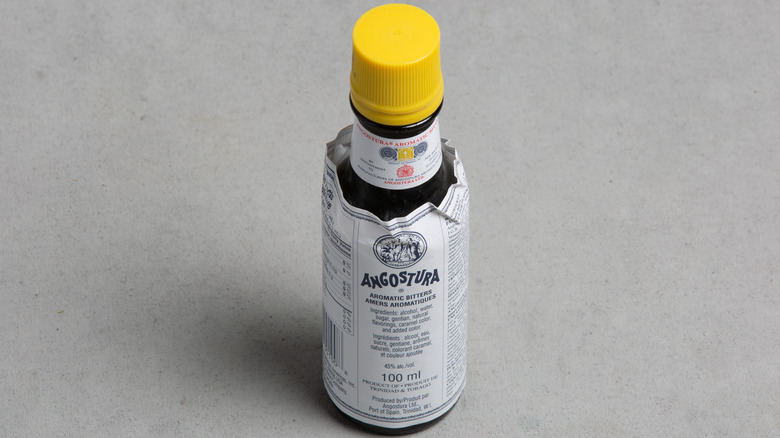The Mistake Responsible For The Classic Oversized Angostura Bitters Label
"Bitter" doesn't exactly have the most positive connotation, even when it comes to taste, but those with culinary knowledge see its worth. There are essentially a handful of base flavors, and when it comes to cocktails, many are already sour and/or sweet. Salt can easily be added to a rim, but bitterness can be more elusive. Bitters exist to rectify precisely that, bringing a dash of complexity to mixed drinks like the old fashioned (there are even some savory cocktails that incorporate umami, the fifth flavor, with a pinch of MSG)
Bitters are extracts of various culinary components that get soaked in neutral alcohol. Common ingredients include fruits, roots, spices, tree barks, and sometimes vegetables. Many classic bitters are "aromatic," which typically means they use fragrant spices like clove, but orange bitters are also popular. Crafting them is a fairly simple process, meaning that you can make your own bitters. Even so, commercial producers often employ advanced techniques and add in colorants, glycerin, and sweeteners or even uncommon flavors such as barbecue, cumin, and peppers.
Bitters can be used for more than just drinks. They also accentuate dishes like potato salad, steamed fish, and whipped cream. It's believed they can soothe upset stomachs, as well, which was their original purpose. In fact, bitters actually predate cocktails, with a history in folk medicine. Nowadays, however, bitters are most associated with mixology, and out of all the brands, Angostura bitters with its oversized label is arguably the most recognizable.
Angostura was a bitter pioneer
Angostura bitters came into existence in 1824, beginning as a tincture designed by Dr. Johann Siegert in Angostura, Venezuela. During the middle of the 19th century, his products earned widespread acclaim as Dr. Siegert exported them across the world. It was around this time that cocktails came to be, and many early mixologists turned to bitters to enhance their concoctions. The creation of beverages such as the champagne cocktail, Manhattan, and pink gin — which all use Angostura bitters — helped to popularize them. As a matter of fact, the award-winning Angostura in particular was present at the first ever cocktail party, and even royals like the kings of England, Prussia, and Spain took notice of it circa the early 1900s.
However, the front half of the 20th century would prove difficult for the growing bitters industry. While the United States' Pure Food & Drug Act passing into law was probably good for consumers, it meant bitters had to clearly display their ingredients, limit alcohol content, and no longer claim to cure ailments such as old age or malaria. WWI and Prohibition did bitters' supply chains no favors, either. Few bitter varieties survived, but fortunately, Angostura did. Starting in the 1940s with the emergence of Tiki drinking culture, bitters were back on top again. Although bitters have long waxed and waned in popularity, they're practically ubiquitous now.
The question remains, though: At what point in Angostura's storied history did it acquire its signature look?
Angostura's label was a happy accident
Dr. Johann Siegert's sons took over the family business in the latter half of the 1800s. During this period, Angostura bitters started winning awards at various expositions, like the 1876 World Trade Fair's first-place prize in Product Excellence. For one other competition, two of the brothers decided to divvy up responsibilities. One of them would design a new bottle while another would create the label to go alongside it. Unfortunately, the two did not communicate, which resulted in a label that was too big for its bottle. There was no time to resolve that issue, so the brothers went ahead and submitted what they had anyway, thus squandering their chances of success — at least, in the short term.
Although the mismatched design did not win, it earned praise for its memorable look from one of the judges. The brothers then chose to make this accident permanent, using it to create a lasting impression in consumers' heads. After all, you can probably picture the brown bottle, yellow cap, and oversized white label in your mind's eye right now (even without looking at the images above). It's ironic; what could have been just a bitter mistake instead turned into a pretty sweet deal!


